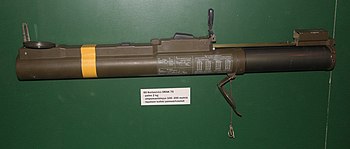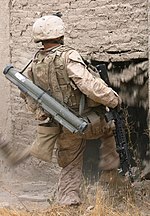From Wikipedia, the free encyclopedia
| M72 LAW | |
|---|---|
|
The M72 LAW in extended position
|
|
| Type | Anti-tank rocket launcher |
| Place of origin | United States of America |
| Production history | |
| Designer | FA Spinale, CB Weeks and PV Choate |
| Designed | Patent filed 1963 |
| Manufacturer | Norway: NAMMO (Raufoss, Norway) U.S.: NAMMO Talley (Mesa, Arizona) Turkey: under license by MKEK |
| Unit cost | 670 € or $876.85 US (Converted) |
| Specifications | |
| Weight | 2.5 kg (5.5 lb) |
| Length | 24.8 in (unarmed) 34.67 in (armed) |
| Caliber | 66 mm |
| Muzzle velocity | 145 m/s (475.7 ft/s) |
| Effective range | 200 m (656.2 feet) |
Detonation
mechanism |
point-initiated, base-detonated |
| 1960s Weapons Similar to M72 | |
In early 1963, the M72 LAW was adopted by the U.S. Army and U.S. Marine Corps as their primary individual infantry anti-tank weapon, replacing the M31 HEAT rifle grenade and the M20A1 "Super Bazooka" in the U.S. Army. It was subsequently adopted by the U.S. Air Force to serve in an anti-emplacement/anti-armor role in Air Base Defense duties.[2][note 1]
It had been intended that, in the early 1980s, the M72 would be replaced by the FGR-17 Viper; but this program was canceled by Congress and the M136 AT4 was introduced in its place. In that time period, its nearest comparison was the Swedish Pskott m/68 (Miniman) and the French SARPAC.[note 2]
Contents
History
During World War II, the sudden prominence of tanks and other armored vehicles on the battlefield led to the creation of man-portable weapons that would enable the humble infantryman to successfully deal with the new threat. The first such weapons to be used (with limited success) were flamethrowers, satchel charges, jury-rigged landmines and specially designed magnetic hollow charges; but, all these weapons needed to get within a couple of meters from the target to be effective, which severely limited said effectiveness and greatly endangered the user.The U.S. Army then introduced the bazooka on the battlefield, the first true rocket-propelled grenade launcher, which proved an effective novel weapon against enemy armor. Despite early problems, it was such a success that many of the nations involved in World War II soon copied it or developed similar weapon systems.
However, the bazooka had its drawbacks. Being large, cumbersome and rather fragile, it needed a dedicated and trained two-man team to be used efficiently. Hard-pressed on all fronts, Germany developed a one man alternative to the bazooka type weapons: the Panzerfaust family of weapons. These one-shot launchers were relatively cheap to manufacture and needed no specialized training; they were so simple to use that they were regularly issued to Volkssturm regiments. They proved remarkably efficient against any tanks they were used against during World War II. Noticeably, they were not rocket launchers but recoilless rifles.
The M72 LAW is a descendant and combination of the two World War 2 weapons; the basic principle is that of a miniaturized bazooka, while its low weight and cheap build allows for general issue and disposability akin to the Panzerfaust.
Description
The weapon consists of a rocket packed inside of a launcher made up of two tubes, one inside the other. While closed, the outer assembly acts as a watertight container for the rocket and the percussion cap-type firing mechanism that activates the rocket. The outer tube contains the trigger, the arming handle, front and rear sights, and the rear cover. The inner tube contains the channel assembly, which houses the firing pin assembly, including the detent lever. When extended, the inner tube telescopes outward toward the rear, guided by the channel assembly, which rides in an alignment slot in the outer tube's trigger housing assembly. This causes the detent lever to move under the trigger assembly in the outer tube, both locking the inner tube in the extended position and cocking the weapon. Once armed, the weapon is no longer watertight, even if the launcher is collapsed into its original configuration.When fired, the striker in the rear tube impacts a primer, which ignites a small amount of powder that "flashes" down a tube to the rear of the rocket igniting the propellant in the rocket motor. The rocket motor burns completely before leaving the mouth of the launcher, producing gases around 1,400 °F (760 °C). The rocket propels the 66mm warhead forward without significant recoil. As the warhead emerges from the launcher, six fins spring out from the base of the rocket tube, stabilizing the warhead's flight.[note 3] The early LAW warhead, developed from the M31 HEAT rifle grenade warhead, uses a simple, but extremely safe and reliable, piezoelectric fuze system. On impact with the target, the front of the nose section is crushed causing a micro-second electric current to be generated, which detonates the warhead. The fuse then detonates a booster charge located in the base of the warhead, which sets off the main warhead charge. The force of the main charge forces the copper liner into a directional particle jet that, in relation to the size of the warhead, is capable of a massive amount of penetration.
A unique mechanical set-back safety on the base of the detonator grounds the circuit until the missile has accelerated out of the tube. The acceleration causes the three disks in the safety mechanism to rotate 90 degrees in succession, ungrounding the circuit; the circuit from the nose to the base of the detonator is then completed when the piezo-electric crystal is crushed on impact.
Ammunition

M72 demonstration at Fort Benning, Georgia in the 1960s. Note the M1 rifle slung over the soldier's back.
A training variant of the M72 LAW, designated the M190, also exists. This weapon is reloadable and uses the 35 mm M73 training rocket. A subcaliber training device that uses a special tracer cartridge also exists for the M72. A training variant used by the Finnish armed forces fires 7.62 mm tracer rounds.
The US Army tested other 66 mm rockets based on the M54 rocket motor used for the M72. The M74 TPA (Thickened Pyrophoric Agent) had an Incendiary warhead filled with TEA (triethylaluminium); this was used in the M202A1 FLASH (FLame Assault SHoulder weapon) 4-tube launcher. The XM96 RCR (Riot Control Rocket) had a CS gas-filled warhead for crowd control and was used with the XM191 quadruple-tube launcher.
Once fired in combat, the launcher is required to be destroyed to prevent its use by the enemy as a booby-trap; the enemy could collapse the launcher to its original configuration, fill it with explosives and shrapnel, and rig it to explode if moved by a soldier believing it to be unused. Due to the single use nature of the weapon, it was issued as what is called a "wooden-round"[4] of ammunition by the Canadian Army and the United States Army, requiring no checks or maintenance, just as small arms ammunition can be stored in the same manner for years without any problems.
Service history
Australia
The M72 rocket has been in Australian service since the Vietnam War.[5][6] Currently, the Australian Defence Force uses the M72A6 variant[7] as an anti-structure and secondary anti-armor weapon. The weapon is used by ordinary troops at the section (squad) level and complements the heavier 84 mm Carl Gustav recoilless rifle and Javelin missile; which are generally utilized by specialized fire support and anti-armor troops.[8]Republic of China
The Republic of China Army (Taiwan) uses the M72 as a secondary anti-armor weapon. It is used primarily as a backup to the Javelin and M136 (AT4) anti-tank weapons.[citation needed]Finland
The M72 LAW is used in the Finnish Army (some 70,000 pieces), where it is known under the designations 66 KES 75 (M72A2, no longer in service) and 66 KES 88 (M72A5). In accordance with the weapon's known limitations, a pair of "tank buster" troops crawl to a firing position some 50 to 150 meters away from the target, bringing with them four to six LAWs, which are then used in rapid succession until the target is destroyed or incapacitated. Due to its low penetration capability, it's mostly used against light armored targets. The M72 is the most common AT weapon in the Finnish Army.[citation needed] Finland has recently upgraded its stocks to the M72 EC LAW Mk.I version. It is designated 66 KES 12.[9] It also fields the bunker buster version, named M72 ASM RC, and locally designated 66 KES 12 RAK. The oldest version 66 KES 75 is now retired.Turkey
The Turkish Army uses a locally-built version by Makina ve Kimya Endustrisi Kurumu, called HAR-66 (Hafif Antitank Roketi, Light Antitank Rocket), which has the performance and characteristics of a mix of M72A2 and A3. Turkey also indigenously developed an anti-personnel warhead version of HAR-66 AP and called it "Eşek Arısı" (Wasp).[10]United Kingdom
The British Army had previously used the NAMMO M72 under the designation "Rocket 66mm HEAT L1A1" but was replaced by the LAW 80 during the 1980s.[11] The M72 rocket was reintroduced into British service under the Urgent Operational Requirement program, with the M72A9 variant being designated the Light Anti-Structures Missile (LASM).[12][13][14]United States
During the Vietnam and post-Vietnam periods, all issued LAWs were recalled due to instances of the warhead exploding in flight, sometimes injuring the operator. After safety improvements, part of the training and firing drills included the requirement to ensure the words "w/coupler" were included in the text description stenciled on the launcher, which indicated the launcher had the required safety modification(s).[citation needed][note 5]With the failure of the M72 replacement the Viper, Congress in late 1982 ordered the US Army to test off-the-shelf light antitank weapons and report back by the end of 1983. In partnership with Raufoss AS, Talley Defense offered the M72E5, which offered increased range, penetration and better sights, which was tested along with five other light anti-armor weapons in 1983. For all the improvements the M72E5 offered the AT4 was chosen to replace the M72.[15][note 6]
Although generally thought of as a Vietnam War era weapon which has been superseded by more powerful AT4, the M72 LAW has found a new lease of life in the ongoing (2006) operations in Iraq by the U.S. Army, the U.S. Marine Corps and Canadian Army in Afghanistan. The lower cost and lighter weight of the LAW, combined with a lack of modern heavy armored targets and the need for an individual assault vs an individual antiarmor weapon, make it ideal for the type of urban combat seen in Iraq and mountain warfare seen in Afghanistan today. In addition, a soldier can only carry one AT4 a mission, but with the LAW he can carry two.[16]
Recently, the U.S. Marine Corps Systems Command at Quantico, Virginia placed a 15.5 million dollar fixed contract order with Talley Defense for 7,750 M72A7s, with delivery to be completed in April 2011.[17][18]






No comments:
Post a Comment